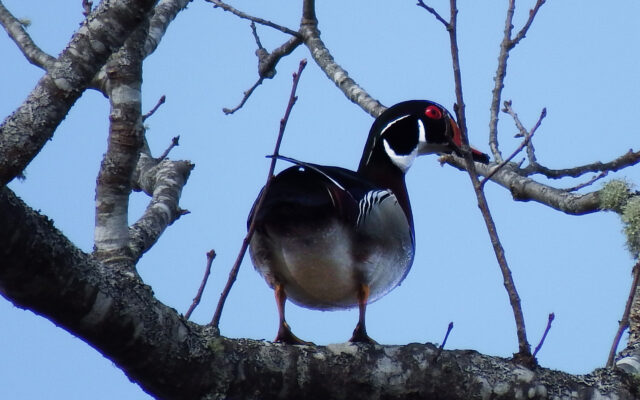
Wintering birds are biding their time in Maine as melting ice ushers in spring
By Bob Duchesne
Water. It’s one of the few chemical compounds that we experience in all its forms in nature: gas (water vapor), liquid (saltwater and freshwater) and solid (ice). In spring, all these forms of water help to determine what’s happening in our backyards.
As I write this, the lake in front of my house is solid. But the ice is turning black, a sure sign that it will break up and disappear shortly. Perhaps by the time this column hits print, it already has.
If so, the loons are now calling in front of my house. I think it is one of nature’s miracles, that the loons know almost instantly when the ice goes out. I’ve fallen asleep at 9 p.m. with the lake still frozen, and awoken to the sound of loons calling at 3 a.m., minutes after the ice broke up in total darkness. How did they know?

The first official day of spring was last weekend, but springtime itself is relative. Nesting areas in northern Canada won’t be ice-free until June. Many birds go there to take advantage of the bountiful food supply that abruptly follows melting.
But until then, there’s no point in hurrying. Many of Maine’s winter sea ducks will remain along our coast until Memorial Day. Purple sandpipers nest farther north than any other shorebird and they will mostly stick around the Maine coastline through May. Even a few snowy owls may linger here that long.
American woodcocks and Wilson’s snipes are shorebirds that prefer marshes over mudflats. Both return early, even up in the north woods where the snow lingers well into April. Even when the snow level is still measured in feet, they can find food around the watery melting edges of the snowdrifts.
Most waterfowl prefer either freshwater or saltwater, but they’ll make do with one while waiting for the other. Most dabbling ducks — ducks that remain afloat while bottom-feeding — nest exclusively on freshwater. But until their freshwater nesting sites thaw, they can be found seaside.
Two uncommon dabblers were spotted last Sunday in a saltwater bay in Winter Harbor during a field trip led by the Penobscot Valley Chapter of Maine Audubon. Three gadwalls and one American wigeon were merely biding their time until their preferred freshwater habitat melted up north. Neither species is a Maine nester.
Shortly, local ponds and marshes will clear of ice. Waterfowl will congregate, waiting for the ice on their breeding grounds to melt. They will even make use of flooded fields.
Expect romance. Many waterfowl pair up before heading north, and there is a lot of courtship going on right now.
The same is true for ocean birds. Many will linger along the Maine coast for another month or more. The farther north they breed, the longer they’ll linger. Many of those same ducks spend their winters on saltwater, but nest on freshwater.
As our own freshwater opens, I expect the dainty little buffleheads to be among the first to move off the coast and into our melting ponds and streams, working their way northward. I’m always surprised to see them in freshwater, but I shouldn’t be.
About the time ice melts on the lakes of Aroostook County, many scoters and eiders will move off the coast and follow the Penobscot and other rivers toward Canada, often stopping on Maine’s northern lakes along the way.
Several species are getting ready for the journey by changing color. Horned and red-necked grebes winter in Maine, and spend their last few weeks here swapping their drab winter feathers for their mate-attracting summer plumage.
Weirdly, long-tailed ducks do just the opposite. They are in their finest feathers in Maine, attracting mates before heading north. Just before leaving, they molt into drab plumage, so they can arrive on their subarctic nesting sites suitably camouflaged.
Water vapor has a huge impact on the timing of migration. The length of daylight and warming temperatures signal birds when to migrate, but storms can block the way. Birds are smart enough to avoid flying into trouble, and they’ll wait for proper conditions.
From April to late May, weather patterns can speed or delay migration. Yearly arrival dates can vary by up to two weeks. It doesn’t even have to be stormy here. Adverse weather in southern states can block migration for a bit.
Soon, water levels will return to normal. Wood ducks will climb down from trees. All waterfowl will disperse to nest. Canada geese will go back to pooping in their favorite places.